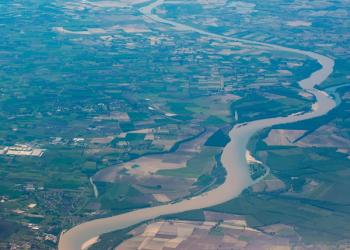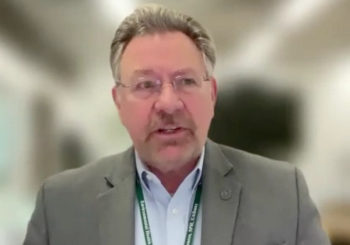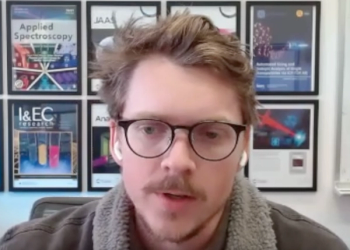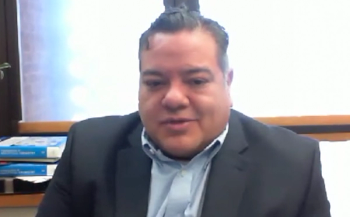
Toward a Generalizable Model of Diffuse Reflectance in Particulate Systems
Key Takeaways
- Diffuse reflectance modeling is challenged by light scattering, absorption, and anisotropic reflectance in heterogeneous particles.
- Traditional models like Kubelka-Munk and radiative transfer theory have limitations in capturing granular-level variability.
This tutorial examines the modeling of diffuse reflectance (DR) in complex particulate samples, such as powders and granular solids. Traditional theoretical frameworks like empirical absorbance, Kubelka-Munk, radiative transfer theory (RTT), and the Hapke model are presented in standard and matrix notation where applicable. Their advantages and limitations are highlighted, particularly for heterogeneous particle size distributions and real-world variations in the optical properties of particulate samples. Hybrid and emerging computational strategies, including Monte Carlo methods, full-wave numerical solvers, and machine learning (ML) models, are evaluated for their potential to produce more generalizable prediction models.
Abstract
Accurately modeling diffuse reflectance in particulate materials remains a complex challenge in spectroscopy, owing to light scattering, absorption, and anisotropic (directional) reflectance behavior across heterogeneous particles. The empirical absorbance model is simple, yet limited by requiring a unique chemometric model for each type of sample. Kubelka-Munk and radiative transfer models offer simplified frameworks, but fail to capture granular-level reflectance variability. This tutorial critically reviews these approaches, introducing their mathematical foundations and limitations. Advanced modeling paradigms such as Monte Carlo simulations, finite element methods, and machine learning (ML)-based spectral prediction are discussed. The goal is to guide and challenge researchers and practitioners toward methods that can better accommodate the complexity of reflectance in real-world particulate samples.
1. Introduction
Diffuse reflectance (DR) spectroscopy is a cornerstone technique in fields ranging from agriculture to pharmaceuticals to planetary science. The challenge of such measurements lies in translating observed reflectance spectra into quantitative or qualitative information about the sample’s chemical composition and physical structure. Modeling the light interactions within a particulate matrix is especially difficult due to multiple scattering events, inhomogeneous particle geometries, and anisotropic surface characteristics. Anisotropic scattering refers to the fact that light is not scattered equally in all directions from a mixed particle surface, but is highly directional and irregular based on the angles of illumination and measured collection signal.
This tutorial introduces foundational modeling theories: empirical absorbance, Kubelka-Munk, radiative transfer theory, and the Hapke model, followed by emerging machine learning (ML) computational methods that seek to address and improve upon these classical methods and their limitations (1–7).
2. Classical Models of Diffuse Reflectance
2.1 Empirical Absorbance Transform in Diffuse Reflectance Spectroscopy
The empirical absorbance transform is a mathematical approximation used in near infrared (NIR) diffuse reflectance spectroscopy where the measured reflectance spectrum R(λ) is converted to a form resembling transmission absorbance using the formula (1):
This transformation is not physically rigorous but is widely used in chemometrics for qualitative analysis and multivariate calibration. It mimics the Beer–Lambert law’s linear relationship between absorbance and concentration, enabling the use of standard linear regression tools like PCA or PLS.
This approach is often used with powdered samples, tablets, and solid matrices where true transmission is not possible, and scattering dominates the optical signal (1).
Basic Empirical Transform:
Where:
- A is the empirical absorbance (dimensionless)
- R is the measured diffuse reflectance (fraction of incident light)
Matrix Notation for Chemometric Modeling:
When applying to multivariate calibration:
Where:
- R∈ ℝⁿˣᵖ is the reflectance matrix (n samples × p wavelengths)
- A∈ ℝⁿˣᵖ is the transformed absorbance matrix
- This is often followed by mean-centering or preprocessing (for example, SNV, MSC, derivatives)
Then, in Partial Least Squares (PLS) regression:
Where:
- T = scores
- P = loadings of spectra
- y = concentration vector
- q = weights
- E, f = residuals
Advantages
- Simple and fast to compute. Easily implemented in software; no need for complex modeling.
- Compatible with multivariate calibration. Enables PCA, PLS, or ML methods to work effectively with DR data.
- Empirically accurate for many applications. Performs well in routine quantitative prediction where samples are similar in matrix and particle properties.
Limitations
- Not physically rigorous. Does not distinguish between absorption and scattering; misrepresents photon–sample interactions.
- Fails with variable sample geometry or heterogeneity. Inaccurate when pathlength or scattering changes significantly across samples, such as with rough surfaces, varying particle sizes, and so forth.
- Poor extrapolation or generalization. Lacks predictive power outside the calibration set or across different sample matrices.
- Requires unique chemometric modeling for each type of sample (is not a first principles reflectance model).
2.2 The Kubelka-Munk (K-M) Model
To begin understanding how light interacts with powdered or granular samples, we look at one of the oldest and simplest models—the Kubelka-Munk model. Developed in the 1930s for paint and paper industries, this model simplifies the complex journey of light into just two directions: light going down into the material and light coming back up. It's a useful tool for thick, uniform samples where light is scattered many times. Despite its age and simplicity, the model is still popular in NIR and visible spectroscopy. However, it has notable limitations, especially for samples that are thin, non-uniform, or have particles of different sizes.
The Kubelka-Munk model was designed for optically thick, diffuse, and homogeneous layers. It is based on a two-flux approximation: one flux going downward and one upward (2).
Where:
- R = reflectance
- K = absorption coefficient
- S = scattering coefficient
- R∞ = May be substituted for the reflectance of an infinitely thick layer. It’s the reflectance after that infinite thickness is reached.
Then the K-M function is:
Advantages:
- Easy to use and fast to calculate.
- Works well for thick, uniform samples.
- Gives a simple way to relate reflectance to absorption and scattering.
Limitations:
- Assumes isotropic scattering.
- Assumes homogeneous optical properties.
- Not valid for thin samples or those with large particle size variability.
2.3 Radiative Transfer Theory (RTT)
When we want a more complete and physically accurate picture of how light moves through a material, radiative transfer theory (RTT) comes into play. Unlike the Kubelka-Munk model, RTT accounts for how light travels in all directions and how it changes due to scattering and absorption. It’s widely used in fields like atmospheric science, medical imaging, and remote sensing. In RTT, light is described as a function that depends on both depth and direction. While this model is very detailed and can simulate complex situations, it’s also much harder to solve and apply—especially when we want to go backward from measured reflectance to find out what’s in the sample.
RTT is more comprehensive and describes the transport of radiation through scattering and absorbing media using the radiative transfer equation (RTE) (3,6):
Where:
- I(z, μ) is the radiance at depth z and direction cosine μ
- Κ is the extinction coefficient
- P(μ, μ′) is the scattering phase function
In matrix form, a discretized RTE can be written:
Where:
- M = discretized transport operator
- I = intensity vector at different angles/depths
- S = source term (includes scattering contributions)
Advantages:
- Models light in all directions, not just two.
- Handles complex scattering and absorption accurately.
- Applies to many sample types, including thin, layered, or inhomogeneous materials.
Limitations:
- Computationally intensive.
- Requires accurate knowledge of phase functions and boundary conditions.
- Difficult to invert for property prediction.
2.4 The Hapke Model
Originally designed for analyzing the surfaces of planets and moons, the Hapke model takes diffuse reflectance theory one step further by including real-world effects like shadows, rough surfaces, and the way particles scatter light depending on angle. This model is valuable for samples where light hits at various angles, common in powdered surfaces. It's particularly useful for remote sensing and materials that are not flat or uniform. However, it relies on several adjustable parameters and can be complex to fit to laboratory data, especially when particles are tightly packed or very small.
Developed for planetary regoliths (a mixture of sand, dust, and rock fragments), the Hapke model accounts for particle phase functions, opposition effects, and surface roughness.
The bidirectional reflectance r(i,e,g) is given by (4):
Where:
- W = single scattering albedo
- μ₀ = cos i , μ = cos e
- i, e, g = incidence, emission, and phase angles
- H(μ) = Chandrasekhar’s function
- B(g) = opposition surge function
- P(g) = phase function
Advantages:
- Is able to model rough, granular surfaces like powders and regoliths
- Handles complex scattering and surface effects
- Widely used in planetary remote sensing
Limitations:
- Parameter-rich and requires empirical fitting.
- Originally intended for planetary surfaces.
- Less accurate for dense powders or layered samples.
3. Hybrid and Computational Modeling Strategies
3.1 Monte Carlo (MC) Simulations
Sometimes, the best way to model light in complex samples is to simulate it one photon at a time. That’s what Monte Carlo (MC) simulations do—they use randomness to trace how many individual photons scatter, reflect, or get absorbed as they move through a sample. These simulations can handle complicated shapes, variable particle sizes, and non-uniform optical properties. They are highly accurate, especially for irregular samples. The trade-off? MC methods require a lot of computational power and detailed input data about the sample’s optical properties. MC methods track photon paths probabilistically.
Let N photons be launched, and each undergo scattering or absorption based on probability distributions derived from optical parameters (5).
Algorithm steps:
1. Launch photon.
2. Sample mean free path s ~ –ln(U)/κ.
3. Update direction via scattering angle from the phase function.
4. Record exit position/intensity.
Advantages:
- Handles complex geometries and anisotropy. Note that isotropicis the same in all directions, and anisotropic is different depending on which way you observe or measure.
- Highly accurate if properly parameterized.
Limitations:
- Requires detailed optical input.
- Computationally intensive.
3.2 Full-Wave Numerical Solvers for Light Transport Modeling
Full-wave numerical solvers are commonly used in engineering, physics, and biomedical optics to simulate how light propagates through complex media. These solvers discretize a physical domain into small elements or volumes and solve the governing equations—typically partial differential equations (PDEs)—that describe light transport, such as the diffusion approximation of the radiative transfer equation (RTE).
This approach is particularly effective when dealing with media that exhibit complex geometries, heterogeneous internal structures, or spatially varying optical properties. Unlike stochastic methods such as Monte Carlo (MC) simulation, which track individual photon trajectories, PDE-based solvers model light behavior as a continuous field, offering precise control over spatial resolution and boundary conditions.
Several numerical techniques can be employed to solve the discretized PDEs (7,8), including:
Finite Element Method (FEM)
Finite Difference Frequency-Domain (FDFD)
Finite Difference Time-Domain (FDTD)
Method of Moments (MoM)
These techniques differ in implementation but share the ability to produce spatially resolved light distribution maps across the medium.
For example, the radiative transfer theory (RTT) can be reformulated as a diffusion-type PDE and solved numerically. A common formulation is:
Where:
∇ = vector differential operator (del)
D = diffusion coefficient
Φ (Phi) = photon fluence rate (photons/cm²·s)
μa = absorption coefficient (cm⁻¹)
S = source term (photons/cm³·s)
After discretization, the PDE can be represented in matrix form:
Where:
A = system matrix (e.g., stiffness matrix in FEM)
Φ = solution vector (fluence at each node)
b = source/load vector
Advantages:
Suitable for complex geometries and spatially varying properties
Provides high spatial resolution
Adaptable to various boundary conditions and solver frameworks
Limitations:
Requires detailed meshing and careful setup
Can be computationally intensive, especially in 3D
Less efficient for media with highly random or disordered structures (e.g., powders or foams)
3.3 Machine Learning Models
With the rise of artificial intelligence (AI), machine learning (ML) has become a promising tool for predicting diffuse reflectance without needing to model every physical process explicitly. ML models can learn patterns in data—like how particle size or composition affects reflectance—just by being trained on many examples. Once trained, these models can make fast and accurate predictions. They’re particularly useful when physical properties are difficult to measure or when models like RTT or Hapke become too complicated to use. However, ML depends heavily on the quality and quantity of the training data, and it can sometimes act like a "black box" with limited interpretability.
ML offers data-driven approaches to predict reflectance from known parameters or spectra.
Let:
- X ∈ ℝⁿˣᵖ: matrix of sample parameters (particle size, composition, etc.)
- y ∈ ℝⁿ: vector of reflectance values
A model (for example, neural network, random forest) is trained (9):
Advantages:
- Can learn complex, nonlinear mappings.
- Bypasses the need for full physical modeling.
Limitations:
- Requires large, high-quality datasets.
- May lack interpretability.
4. Discussion and Future Research
The need for a generalizable, accurate, and computationally efficient model of diffuse reflectance remains unsolved. Classical methods like Kubelka-Munk and Hapke, while useful, are fundamentally limited in generality. RTT is physically rigorous but challenging to invert or apply broadly. RTT is very accurate because it’s based on the real physics of how light moves and scatters in a material, but it’s hard to work with, especially when trying to go backwards from measured data to figure out the material’s properties (a process called inversion). It’s also not easy to apply to all types of samples, particularly those that are complex or irregular.
Future efforts may focus on hybrid models that combine the strengths of physics-based simulations (for example, MC, FEA) with ML’s flexibility. For instance, ML models trained on MC simulation results could serve as rapid surrogates. Uncertainty quantification, spectral transfer calibration, and explainable AI should also be incorporated to improve model reliability and adoption.
Open-source simulation tools (e.g., MCX, NIRFast, COMSOL) and shared datasets for training ML models may accelerate progress. Developing frameworks that link microstructure descriptors (particle shape, porosity, etc.) with spectral output in an interpretable way remains a major challenge and opportunity.
Note: Here is an explanation of the open-source (and partially commercial) simulation tools referenced, MCX, NIRFast, and COMSOL, including what they do and how they're used in the context of modeling diffuse reflectance (10–12).
References
(1) Workman, J., Jr.; Weyer, L. Practical Guide and Spectral Atlas for Interpretive Near-Infrared Spectroscopy; CRC Press: Boca Raton, FL, 2012. DOI:
(2) Kubelka, P.; Munk, F. Ein Beitrag zur Optik der Farbanstriche. Z. Tech. Phys. 1931, 12, 593–601.
(3) Chandrasekhar, S. Radiative Transfer; Dover Publications: New York, 1960.
(4) Hapke, B. Bidirectional Reflectance Spectroscopy: 1. Theory. J. Geophys. Res. 1981, 86 (B4), 3039–3054. DOI:
(5) Wang, L.–H.; Jacques, S. L.; Zheng, L. MCML—Monte Carlo Modeling of Light Transport in Multi-Layered Tissues. Comput. Methods Programs Biomed. 1995, 47 (2), 131–146. DOI:
(6) Arridge, S. R. Optical Tomography in Medical Imaging. Inverse Probl. 1999, 15 (2), R41–R93. DOI:
(7) Davidson, D. B. Computational Electromagnetics for RF and Microwave Engineering, 2nd ed.; Cambridge University Press, 2010.
(8) Rumpf, R. C. Electromagnetic and Photonic Simulation for the Beginner: Finite-Difference Frequency-Domain in MATLAB; Artech House: Boston, MA, 2022.
(9) Verrelst, J.; Alonso, L.; Camps‑Valls, G.; Delegido, J.; Moreno, J. Machine Learning Regression Algorithms for Biophysical Parameter Retrieval: Opportunities for Sentinel‑2 and ‑3. Remote Sens. Environ. 2012, 118, 127–139. DOI:
(10) MCX (Monte Carlo eXtreme), GPU‑accelerated open‑source Monte Carlo photon transport simulator.
(11) NIRFast (Near‑Infrared Fast Toolbox), open‑source MATLAB package for diffuse optics and finite-element modeling. Available online:
(12) COMSOL Multiphysics, commercial multiphysics FEM software including radiative transfer modules.
_ _ _
This article was partially constructed with the assistance of a generative AI model and has been carefully edited and reviewed for accuracy and clarity.
Newsletter
Get essential updates on the latest spectroscopy technologies, regulatory standards, and best practices—subscribe today to Spectroscopy.



